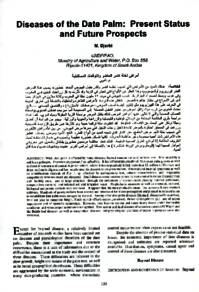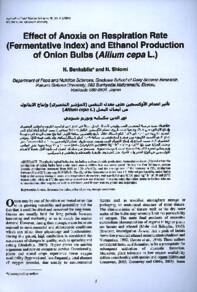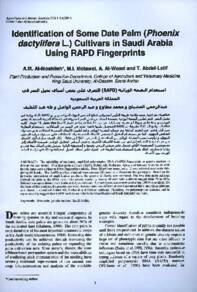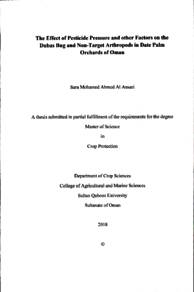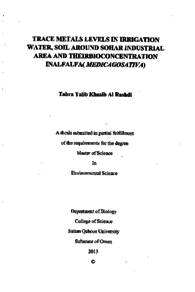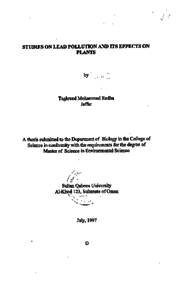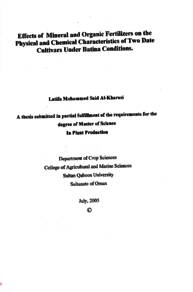Document
Diseases of the date palm present status and future prospects.
Publisher
Sultan Qaboos university
Gregorian
1998
Language
English
English abstract
While date palm is affected by many diseases, bayoud remains the most serious one. It is caused by a soil born pathogen, Fusarium oxrysporum f.sp. albedinis. It has affected practically all Moroccan palm groves as well as those of western and central Algerian sahara, where it has respectively killed more than 12 million in Morocco and three million in Algeria and has accelerated the desertification phenomenon. External and internal symptoms as well as identification methods of F. o. f. sp. albedinis by pathogenicity test, cultural characteristics, and vegetative compatibility were reviewed and discussed. Small distance contamination occurs by root contact between diseased trees and healthy ones, and at large distances through the movement of contaminated planting material (offshoots, symptomless carriers) and infested soil and irrigation water. Prophylactic measures as well as chemical, cultural, biological and genetic controls were reviewed. It appears that the most productive mean lies in research into resistant cultivars. Hundreds of genotypes have been selected and introduced for micro-propagation and planted in infested areas to rehabilitate date palm oasis ravaged by bayoud. Among other date palm diseases Khamedj (Mauginiella scaettae), fruit rot (due to numerous fungi). Black scorch (Thielaviopsis paradoxa), Belaat (Phytophtora sp.) are of minor importance and of sporadic occurrence. However, they become serious and cause heavy losses under favourable conditions and when proper sanitation is not applied. Two serious and fatal diseases of unknown causes (AI Wijam and the Brittle leaf disease) as well as many other diseases and physiological disorders of minor importance were also reviewed.
Member of
ISSN
2410-1079
Resource URL
Citation
Djerbi, M. (1998). Diseases of the date palm: present status and future prospects. Journal of Agricultural and Marian Sciences, 3 (1), 103-114.
Arabic abstract
هنالك العديد من الأمراض التي تصيب نخلة التمر ولكن يظل البيوض أشدها خطورة، يسبب هذا المرض الفطر فيرزيريوم أوكسيسبروم، وهذا الفطر من الأنواع التي تعيش في التربة وقد تأثرت به كل زراعات النخيل في المغرب وفي غرب ووسط الصحراء الجزائرية، تسبب البيوض في موت 12 مليون نخلة في المغرب وثلاثة ملايين في الجزائر مما أدى إلى الإسراع في انتشار ظاهرة التصحر. تناقش هذه الدراسة الأعراض الظاهرة والداخلية، بالإضافة إلى الطرق المتبعة في التعرف على هذا الفيوزيريوم مثل اختيار كيفية تسبب المرض، مواصفات الاستزراع، والتناسق الجسدي ..... الخ. تحدث العدوى من قرب حيث ينتقل المرض من جذور النخيل المصابة إلى الصحيحة أما من بعد فتنتقل العدوى بواسطة الفصائل المصابة والتي لا تظهر عليها أعراض المرض كذلك ينتقل المرض بواسطة التربة المنقولة ومياه الري. كما تمت مراجعة طرق المكافحة المختلفة من الوسائل الوقائية والكيميائية والزراعية والحيوية والوراثية. ويبدو من الدراسة أن أفضل وسيلة ترتكز على البحث عن الأصناف المقاومة. لقد اختيرت مائة تركيبة جينية وتم إكثارها عن طريق الزراعة النسيجية وزرعت في المناطق المتأثرة بالمرض لإعادة تأهيل واحات النخيل التي دمرها مرض البيوض. من بين الأمراض الأخرى التي تصيب نخلة التمر مرض الخامج، عفن الثمار الذي تسببه العديد من أنواع الفطر، اللفح الأسود ومرض بلعات. تعتبر هذه الأمراض ذات أهمية محدودة وغير منتظمة الحدوث، لكنها تشكل خطورة عظيمة وتتسبب في خسارات بالغة تحت الظروف الملائمة إذا لم تتبع الطرق الصحية السليمة. كذلك تمت مناقشة مرضين خطيرين يفتكان بالنخيل غير معروفي العوامل المسببة لهما (الوجام ومرض الورقة المتكسرة) هذا بالإضافة إلى أمراض أخرى عديدة وتداعيات فسيولوجية أقل أهمية.
Category
Journal articles

